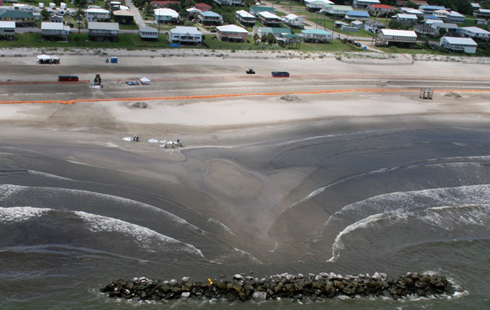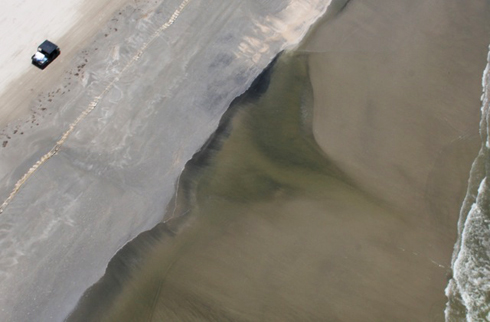Did you know that Truthout is a nonprofit and independently funded by readers like you? If you value what we do, please support our work with a donation.
On July 20, I decided to try to get behind the media blockade of oil clean-up operations at Grand Isle, Louisiana. Grand Isle is the only inhabited island in the Gulf Barrier Islands, and has been under especially tight media blackout for months. I had heard unconfirmed stories that BP clean-up workers were “burying the oil under the sand,” and I wanted to get behind the scenes myself.
Very early into the oil-spill catastrophe, an unprecedented blockade of the media had taken hold in the Gulf. Many journalists pointed fingers only at BP, but this was misleading, as a motley alliance of federal Coast Guard officials, BP, the FAA, the National Guard, sundry private contractors, local law enforcement and parish officials have all conjoined to prevent journalists, filmmakers, photographers and the general public from access to oil-damaged areas. A strange militarization took place to justify the restrictions, with the Gulf increasingly described as a “war zone” and the media as “embeds.” One journalist told me a Coast Guard official had barred him access to Grand Isle saying, “It’s like the Patriot Act.”

Clean-up workers on Grand Isle.
(Photo: Anne McClintock, Copyright 2010)
Reporters and photographers for numerous outlets such as Mother Jones, CBS, the New Orleans Times-Picayune and AP, among others, widely documented the restrictions. After these early protests, Adm. Thad Allen, commander of the Coast Guard, guaranteed the media “uninhibited access,” but the blockade only tightened. Flyover permits were revoked by the FAA and aerial access was restricted, with media flights at one point denied permits to fly below 900 feet over clean-up areas. Bird-cleaning facilities at Fort Jackson were closed to the media except for a couple of days a week. National Guardsmen prevented even CNN from filming oil-damaged birds. BP’s clean-up workers were contractually threatened with job loss if they spoke with the media. Sick workers were forbidden to speak to journalists. A film crew was barred from filming a medical mobile unit at Venice. Local animal welfare activists testified that dead birds and other marine life were being removed from beaches at night by anonymous officials to hide visible evidence of the impact on wildlife.
In a particularly egregious gesture, BP prevented clean-up workers from wearing respirators, presumably to forestall future liability claims, as the masks make visible the fact that clean-up conditions are potentially hazardous to workers’ health.

Clean-up operations at Grand Isle.
(Photo: Anne McClintock, Copyright 2010)
On June 30, matters took a more serious turn. The Coast Guard at the Joint Information Center at Houma, Louisiana, passed an unprecedented ruling: no one would be allowed to enter an invisible 20-meter exclusion zone placed around booms and response vessels. Anyone who violated the ruling could get slapped with a hefty $40,000 fine and possible Class D felony charges, which can carry a one to five year prison sentence.

Grand Isle beach.
(Photo: Anne McClintock, Copyright 2010)

Grand Isle clean-up workers.
(Photo: Anne McClintock, Copyright 2010)
A prompt uproar of protest ensued. The ACLU of Louisiana wrote an open letter to the media declaring the ruling unconstitutional. The Coast Guard did an abrupt about-turn, publicly announcing that they were dropping the 20-meter exclusion rule and assuring members of the media they could get unfettered access if they provided certification. But, as I and many others soon found out, this gesture was nominal at best. On the ground, affairs stayed much the same. During my first evening in southern Louisiana, I spoke with a team from the Cornell Laboratory of Ornithology, who were still fuming at being evicted that day from East Grand Terre Island, where they had been documenting oil-damaged birds. Another journalist told me he had been denied access to Grand Isle beaches in case he got struck by lightning. Another told me he had been denied access to Grand Isle because “the roads need repairing.”

Grand Isle clean-up workers.
(Photo: Anne McClintock, Copyright 2010)
Less visibly and more insidiously, BP began to offer contracts with exceptionally compromising restrictions to scientists in the area who were conducting research into the effects of the oil spill. Several faculty members confirmed to the American Association of University Professors that they had been offered contracts by BP that carried restrictive confidentiality clauses, including a gag on publishing, sharing and talking about research results for three years. Most egregiously, faculty under contract to BP would be unable to testify against the company in court, but would be available to testify on behalf of the company. And scientists could communicate only through lawyers, raising the dismaying prospect that future scientific research findings would be fettered by lawyer-client privilege. A nationwide academic protest has now been launched to challenge this frank corporate attempt to fetter academic freedom and manipulate scientific research.

Grand Isle clean-up operations.
(Photo: Anne McClintock, Copyright 2010)
I had been told one could gain access to Grand Isle beaches only under the careful choreography of a Coast Guard escort. So, I decided to try the skies instead. I heard the FAA had been rescheduling and deferring flyovers, but I hoped that determination and a sleepy lunchtime hour might help. So, I chartered a four-seater Cessna. Then, flying low over the hauntingly lovely, green filigree of the vanishing Barataria Bay marshes, I managed to persuade our at first hesitant, then obliging and curious, pilot to fly over Grand Isle.

Useless boom on Grand Isle marshes.
(Photo: Anne McClintock, Copyright 2010)

Soiled marshland at Grand Isle.
(Photo: Anne McClintock, Copyright 2010)
This is what we saw. Whatever else the photos reveal, one fact is clear: Grand Isle has been a particularly favored beneficiary of clean-up efforts for nearly three months and it is still not remotely clean. Grand Isle is only one island in a vast expanse of oil-soaked Gulf, invaluable nature preserves, fragile barrier islands, pelican rookeries, oyster beds, vulnerable marshes and immense fishing waters. Despite the use of massive and undisclosed, amounts of toxic dispersants to “disappear” the visible oil on the surface and the combined efforts of federal and BP officials to disappear the story from the news, the calamity in the Gulf remains gargantuan and any real clean-up will be many, many years off, if ever.

Grand Isle beach clean-up.
(Photo: Anne McClintock, Copyright 2010)

Grand Isle beach.
(Photo: Anne McClintock, Copyright 2010)
Media that fights fascism
Truthout is funded almost entirely by readers — that’s why we can speak truth to power and cut against the mainstream narrative. But independent journalists at Truthout face mounting political repression under Trump.
We rely on your support to survive McCarthyist censorship. Please make a tax-deductible one-time or monthly donation.
